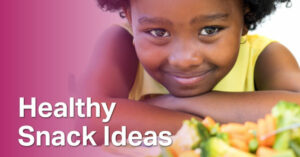Partner Resources
Identifying Gluten-Free Foods
Learn how to identify gluten-free foods and get a yummy gluten-free snack recipe.
Read MoreCelebrate National Dairy Month
Did you know that June is National Dairy Month? National Dairy Month was established in 1937 as “National Milk Month.” Now we appreciate the wide variety of milk and dairy foods that contribute to healthy, sustainable and delicious eating patterns. Our partners at the Dairy Council of California have some ideas and resources to help you celebrate.
Read MoreBelonging and Responsibility
With the help of caring adults, little ones can feel empowered and encouraged to find ways to be helpful, kind, and contribute to their communities. Our partners at Sesame Street in Communities have created new bilingual resources to help children instill a sense of belonging and responsibility in the world. New resources include four videos, two articles, six printables, and a volunteer tip sheet.
Read MoreHealthy Snack Ideas
Healthy snacks taste delicious and fuel children’s growing bodies, laying the foundation for a lifetime of healthy choices. The Institute of Child Nutrition’s Mealtime Memo explores practices to incorporate nutritious, fun, and creative snacks into menus.
Read MoreTips on Identity
Identity is a mix of how we see ourselves, our dreams for the future, and the groups we belong to. Young children notice these things and are building a sense of who they are. This new Tip collection from our partners at Vroom explores how kids of all backgrounds can build positive self-awareness.
Read MoreGet Moving Together
Looking to incorporate more movement in your child care for Physical Fitness Month? You can join in on the fun too! Our partners at Sesame Street in Communities have resources to help get you and the kids moving.
Read MoreFitness for Toddlers and Preschoolers
Did you know that May is Physical Fitness and Sports Month? As toddlers and preschoolers build new skills and have a greater ability to move around more, it’s important that caregivers encourage physical activity and make sure they get the amount necessary for their fitness. Our partners at Nemours share information on how much activity toddlers and preschoolers require and they provide tips on some fun games you can tryout in your child care.
Read MoreCulinary Basics: Mise En Place
If you are not a chef or lack a culinary background, the term “mise en place” may seem like French to you. However, it is a necessary skill to utilize in all kitchens (big and small) when preparing meals. The Institute of Child Nutrition’s May Mealtime Memo will define the term and identify the steps to maximize efficiency and reduce errors in the kitchen.
Read MoreLearn and Grow: Inside, Outside, On the Go
Whether inside, outside, or on the go, children can move their bodies, explore basic concepts in math and science, build language skills, and develop social skills. Out partners at Sesame Street in Communities have new bilingual (English and Spanish) resources including a set of activity cards and a new interactive game.
Read MoreReducing Added Sugars
The sweetness of sugar may tempt our tastebuds, but the health consequences of eating too much sugar are concerning, especially for children whose dietary habits and taste preferences are still developing. The Institute ofChild Nutrition’s April Mealtime Memo uncovers the secrets of added sugars and equip you with the knowledge to identify them in the products you consume.
Read More









